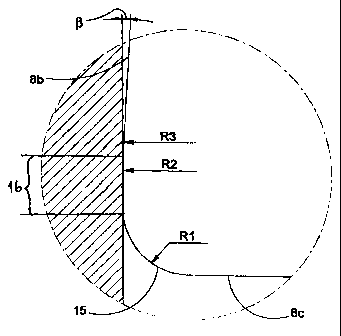Some of the information on this Web page has been provided by external sources. The Government of Canada is not responsible for the accuracy, reliability or currency of the information supplied by external sources. Users wishing to rely upon this information should consult directly with the source of the information. Content provided by external sources is not subject to official languages, privacy and accessibility requirements.
Any discrepancies in the text and image of the Claims and Abstract are due to differing posting times. Text of the Claims and Abstract are posted:
| (12) Patent: | (11) CA 2332285 |
|---|---|
| (54) English Title: | CUTTING INSERT FOR GROOVING |
| (54) French Title: | PLAQUETTE DE RAINURAGE |
| Status: | Expired and beyond the Period of Reversal |
| (51) International Patent Classification (IPC): |
|
|---|---|
| (72) Inventors : |
|
| (73) Owners : |
|
| (71) Applicants : |
|
| (74) Agent: | GOWLING WLG (CANADA) LLP |
| (74) Associate agent: | |
| (45) Issued: | 2007-04-03 |
| (86) PCT Filing Date: | 1999-05-20 |
| (87) Open to Public Inspection: | 1999-12-02 |
| Examination requested: | 2003-11-20 |
| Availability of licence: | N/A |
| Dedicated to the Public: | N/A |
| (25) Language of filing: | English |
| Patent Cooperation Treaty (PCT): | Yes |
|---|---|
| (86) PCT Filing Number: | PCT/SE1999/000860 |
| (87) International Publication Number: | WO 1999061187 |
| (85) National Entry: | 2000-11-14 |
| (30) Application Priority Data: | ||||||
|---|---|---|---|---|---|---|
|
A cutting insert for grooving
operations includes a shank portion and a forward
cutting head. The shank portion includes
an upper surface, a bottom surface and side
surfaces, wherein a line of intersection
between the upper side and a forward clearance
face forms a main cutting edge. Between
the main cutting edge and a secondary
cutting edge there is provided a corner cutting
edge. The comer cutting edge comprises a
primary curved edge with a first radius
extending from the main cutting edge, and a
secondary curved edge with a second radius,
larger than the first radius, that extends from
the primary edge to a side edge and oriented
perpendicular to the main cutting edge. The
cutting insert also comprises an upper side
confined by two longitudinal ridges and an
elongated chip forming recess therebetween.
L'invention concerne une plaquette destinée à des opérations de rainurage et comprenant une partie tige et une tête de coupe avant. La partie tige comprend une surface supérieure, une surface inférieure et des surfaces latérales, une ligne d'intersection entre le côté supérieur et une face en dépouille avant constituant un bord de coupe principal. Un bord de coupe angulaire est situé entre le bord de coupe principal et un bord de coupe secondaire. Le bord de coupe angulaire comprend un premier bord incurvé doté d'un premier rayon s'étendant du principal bord de coupe, et un deuxième bord de coupe doté d'un deuxième rayon qui est plus large que le premier rayon, qui s'étend à partir du bord latéral et qui est orienté perpendiculairement par rapport au principal bord de coupe. La plaquette comprend également un bord supérieur flanqué de deux arêtes longitudinales entre lesquelles se trouve un creux allongé destiné à la formation d'un copeau.
Note: Claims are shown in the official language in which they were submitted.
Note: Descriptions are shown in the official language in which they were submitted.

2024-08-01:As part of the Next Generation Patents (NGP) transition, the Canadian Patents Database (CPD) now contains a more detailed Event History, which replicates the Event Log of our new back-office solution.
Please note that "Inactive:" events refers to events no longer in use in our new back-office solution.
For a clearer understanding of the status of the application/patent presented on this page, the site Disclaimer , as well as the definitions for Patent , Event History , Maintenance Fee and Payment History should be consulted.
| Description | Date |
|---|---|
| Time Limit for Reversal Expired | 2017-05-23 |
| Letter Sent | 2016-05-20 |
| Grant by Issuance | 2007-04-03 |
| Inactive: Cover page published | 2007-04-02 |
| Inactive: Final fee received | 2007-01-15 |
| Pre-grant | 2007-01-15 |
| Notice of Allowance is Issued | 2006-08-11 |
| Letter Sent | 2006-08-11 |
| Notice of Allowance is Issued | 2006-08-11 |
| Inactive: Approved for allowance (AFA) | 2006-06-12 |
| Amendment Received - Voluntary Amendment | 2006-05-09 |
| Inactive: S.30(2) Rules - Examiner requisition | 2005-11-10 |
| Letter Sent | 2005-10-11 |
| Letter Sent | 2005-06-17 |
| Inactive: IPRP received | 2004-05-04 |
| Amendment Received - Voluntary Amendment | 2003-12-24 |
| Letter Sent | 2003-12-02 |
| Request for Examination Received | 2003-11-20 |
| Request for Examination Requirements Determined Compliant | 2003-11-20 |
| All Requirements for Examination Determined Compliant | 2003-11-20 |
| Letter Sent | 2001-03-19 |
| Inactive: Cover page published | 2001-03-12 |
| Inactive: First IPC assigned | 2001-03-08 |
| Inactive: Notice - National entry - No RFE | 2001-02-28 |
| Application Received - PCT | 2001-02-23 |
| Application Published (Open to Public Inspection) | 1999-12-02 |
There is no abandonment history.
The last payment was received on 2006-04-13
Note : If the full payment has not been received on or before the date indicated, a further fee may be required which may be one of the following
Please refer to the CIPO Patent Fees web page to see all current fee amounts.
Note: Records showing the ownership history in alphabetical order.
| Current Owners on Record |
|---|
| SANDVIK INTELLECTUAL PROPERTY AB |
| Past Owners on Record |
|---|
| JORGEN WIMAN |
| PAR TAGTSTROM |